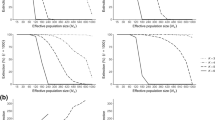Abstract
Enzyme polymorphisms in the sea urchinEchinometra mathaei were examined to test the relative influences of population turnover and patchiness in recruitment on genetic heterogeneity. We found that the total variance in allelic frequency among three populations separated by approximately 4 km at Rottnest Island, Western Australia (collected in February 1985) is as large as that among five additional samples collected over a distance of 1 300 km along the Western Australian coast in August 1987. This suggests that the forces causing genetic differentiation act on a local scale and occur in a single generation. A comparison of sites with different histories of recruitment indicates that the observed genetic differences among age groups are the result of prerecruitment effects, and that differences among sites reflect their individual histories of recruitment.
Similar content being viewed by others
Literature cited
Berger, E. (1973). Gene-enzyme variation in three sympatric species ofLittorina. Biol. Bull. mar biol. Lab., Woods Hole 145: 83–90
Ebert, T. A. (1982). Longevity, life history and relative body wall size in sea urchins. Ecol. Monogr. 52: 353–394
Johnson, M. S. (1974). Comparative geographic variation inMenidia. Evolution, Lawrence, Kansas 28: 607–618
Johnson, M. S., Black, R. (1982). Chaotic genetic patchiness in an intertidal limpet,Siphonaria sp. Mar. Biol. 70: 157–164
Johnson, M. S., Black, R. (1984a). The Wahlund effect and the geographical scale of variation in the intertidal limpetSiphonaria sp. Mar. Biol. 79: 295–302
Johnson, M. S., Black, R. (1984b). Pattern beneath the chaos: the effect of recruitment on genetic patchiness in an intertidal limpet. Evolution, Lawrence, Kansas 38: 1371–1383
Johnson, M. S., Black, R. (1990). Genetic divergence of venerid clams in Shark Bay. In: Berry, P., Bradshaw, S. D., Wilson, B. R. (eds.) Research in Shark Bay. Western Australian Museum, Perth (in press)
Keough, M. J., Downes, B. J. (1982). Recruitment of marine invertebrates: the role of active larval choices and early mortality. Oecologia 54: 348–352
Koehn, R. K., Milkman, R., Mitton, J. B. (1976). Population genetics of marine pelecypods. IV. Selection, migration and genetic differentiation in the blue musselMytilus edulis. Evolution, Lawrence, Kansas 30: 2–32
Koehn, R. K., Newell, R. I. E., Immermann, F. (1982). Maintenance of an aminopeptidase cline by natural selection. Proc. natn. Acad. Sci. U.S.A. 77: 5385–5389
Koehn, R. K., Turano, F. J., Mitton, J. B. (1973). Population genetics of marine pelecypods. II. Genetic differences in microhabitats ofModiolus demissus. Evolution, Lawrence, Kansas 27: 100–105
Nash, W. J., Goddard, M., Lucas, J. S. (1988). Population genetic studies of the crown-of-thorns starfish,Acanthaster planci (L.), in the Great Barrier Reef region. Coral Reefs 7: 11–18
Nishida, M., Lucas, J. S. (1988). Genetic differences between geographic populations of the crown-of-thorns starfish throughout the Pacific region. Mar. Biol. 98: 359–368
Pearse, J. S., Phillips, B. F. (1968). Continuous reproduction in the Indo-Pacific sea urchinEchinometra mathaei at Rottnest Island, Western Australia. Aust. J. mar. Freshwat. Res. 19: 161–172
Scheltema, R. S. (1971). Larval dispersal as a means of genetic exchange between geographically separated populations of shallow water benthic marine gastropods. Biol. Bull. mar. biol. Lab., Woods Hole 140: 284–322
Selander, R. K., Smith, M. H., Yang, S. H., Johnson, W. E., Gentry, J. B. (1971). Biochemical polymorphism and systematics in the genusPeromyscus. I. Variation in the old-field mouse (Peromyscus polionotus). Stud. Genet., Austin, Tex. 6: 49–90
Tracey, M. L., Bellet, N. F., Gravem, C. D. (1975). Excess allozyme homozygosity and breeding population structure in the musselMytilus californianus. Mar. Biol. 32: 303–311
Underwood, A. J., Fairweather, P. G. (1989). Supply-side ecology and benthic marine assemblages. Trends Ecol. Evol. 4: 17–20
Waples, R. S. (1987). A multispecies approach to the analysis of gene flow in marine shore fishes. Evolution, Lawrence, Kansas 41: 385–400
Weir, B. S., Cockerham, C. C. (1984). Estimating F-statistics for the analysis of population structure. Evolution, Lawrence, Kansas 38: 1358–1370
Winans, G. A. (1980). Geographic variation in the milkfishChanos chanos. I. Biochemical evidence. Evolution, Lawrence, Kansas 34: 558–574
Workman, P. L., Niswander, J. D. (1970). Population studies on southwestern Indian tribes. II. Local genetic differentiation in the Papago. Am. J. hum. Genet. 22: 24–29
Zouros, E., Foltz, D. W. (1984). Possible explanations of heterozygote deficiency in bivalve molluscs. Malacologia 25: 583–591
Zouros, E., Singh, S. M., Miles, H. E. (1980). Growth rate in oysters: an overdominant phenotype and its possible explanations. Evolution, Lawrence, Kansas 34: 856–867
Author information
Authors and Affiliations
Additional information
Communicated by G. F. Humphrey, Sydney
Rights and permissions
About this article
Cite this article
Watts, R.J., Johnson, M.S. & Black, R. Effects of recruitment on genetic patchiness in the urchinEchinometra mathaei in Western Australia. Mar. Biol. 105, 145–151 (1990). https://doi.org/10.1007/BF01344280
Accepted:
Issue Date:
DOI: https://doi.org/10.1007/BF01344280




